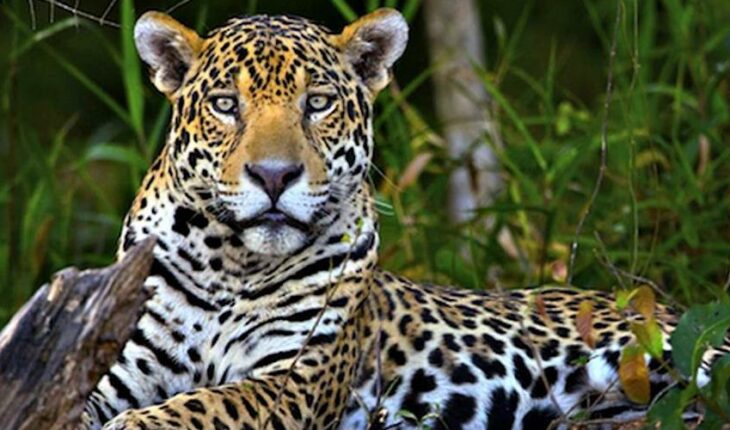Jesús Valle Guzmán is one of the most veteran defenders of the Sierra de Quila, a protected natural area in western Mexico that in August 2022 celebrates 40 years of having been decreed by the federal government. For almost 20 years, with his camera-traps, the naturalist eagerly searched for a jaguar specimen, since the big cat had not been seen for decades.
It was in 2018, when there was evidence of the presence of the jaguar (Panthera onca) in the Sierra de Quila. “It was amazing and exciting,” confesses Efrén Moreno Arzate, from the University of Guadalajara, who led the academic group that, within the framework of a doctoral research, obtained the images of the feline.
Valle Guzman’s intuition had been correct
Panoramic view of an area of the Sierra de Quila. Photo: Conanp.
The researchers who obtained the evidence had a vast team: the effort of 30 people and 90 cameras set up in three areas over a year and a half.
“I came to live here, from Guadalajara, in 1975, and by then, the Mexican government had almost eradicated predators from all over the country,” recalls Valle Guzmán, who stayed in Tecolotlán as a rural doctor and spent time hunting. That hobby left her the day she saw a group of wolves eating a deer that he had finished, in 1995, in this same area, “and I have regretted very much not having a camera to record it.” Since then he migrated completely to the camera.
Valle Guzmán is certain that the jaguar never left the Sierra de Quila. He managed to detect footprints, but attempts to photograph him were unsuccessful, until Moreno Arzate’s team succeeded. Since then, his cameras and those of the direction of the Sierra de Quila Flora and Fauna Protection Area, have taken still photos and videos of the impressive feline.
“That shows that there is a management of the reserve that, despite the problems of the immediate past, bears fruit,” says the Secretary of Environment of Jalisco, Sergio Graf Montero.
The Sierra de Quila, endowed with 15,192 hectares according to the decree of August 4, 1982, changed its management model in the last three years. It depends on the National Commission of Natural Protected Areas (Conanp), but was ceded in co-administration to the government of Jalisco, in 1996. and for more than two decades it depended on a civil association, which according to Graf Montero, did not make its accounts transparent and restricted participation in the management of the area. Since 2019 it has become a decentralized public body (DPO) and has managed to improve its management.
The presence of jaguar reveals the success of the decree and the improvement of work, since the Sierra de Quila is an essential biological corridor.
Jaguar footprints in the Sierra de Quila. Photo: courtesy of Conanp.
Read more | A forest corridor for the jaguar: the bet of biologists and communities to save the felines that still remain in Guerrero | VIDEOS
A species that adapts
The jaguar specialist, and for more than a decade, national president of the Conanp subcommittee for the conservation of the species, Rodrigo Núñez Pérez, comments that thanks to the monitoring work carried out with camera traps, there is evidence that the largest predator in Tropical America usually moves through territories that were not previously considered as of their taste and adaptation.
For example, there is video evidence of a male jaguar roaming the winter snows in Chihuahua, northern Mexico. “A thing that nobody considered before. How is a species that likes torrid climates so much going to walk in the high mountains and between snowy territories?” In his opinion, what has been discovered is the surprising resilience of these felines, which although they do not have a range of distribution as extensive as the puma (Puma concolor), are very flexible to many ecosystems, climates and resource disposition.
“Above all, we must talk about males, who usually move in search of territories. An indication of how they use a broker is to know if it is a solitary individual; if so, it is most likely male, and only passing through.”
Females, who must ensure the safety and feeding of puppies, are usually more restricted to subtropical environments, where breeding conditions are not so extreme, nature grows stronger and it is possible that the different shades found in these ecosystems better protect the offspring of other predators and human hunters.
Sierra de Quila. Photo: courtesy of Conanp.
Read more | Mexico: the challenge of conserving one of the last jaguar refuges on the coast of Jalisco
A history of conservation
The Sierra de Quila is located 80 kilometers west of the city of Guadalajara, capital of the state of Jalisco and with almost 5.5 million inhabitants. One of its many socio-environmental relevances has to do with the recharge of water, as it provides the resource to headwaters and towns that total more than 200 thousand inhabitants.
In addition, this forest region is one of the headwaters of the Ayuquila River, which goes down to the valleys of Autlán and Armería to supply an important emporium of export agriculture, and flows into the Pacific Ocean in the area of Boca de Pascuales, very close to Manzanillo, the largest merchant port in the country.
In the Sierra de Quila “we have been able to detect up to 36 perennial springs, which is very important for the quality of life and the economy of the lower parts,” says the director of the decentralized public body, Javier Sampayo Lazcano.
Formed mainly by pine and oak forests typical of temperate environments, in its high areas; the Sierra de Quila houses in its ravines a wide tropical deciduous forest and gallery vegetation in the areas most contiguous to rivers and streams. This gives rise to a wide biological diversity that has led to unsuspected findings.
In addition to the jaguar, there is the presence of ocelot (Leopardus pardalis), of an axolotl endemic to this region of the country (Ambystoma flavipiperatum) and recently there were otter sightings (Lontra longicaudis), which was believed to be extinct from the area and is common in coastal environments.
In flora, there are relicts of cycads – considered “living fossils” – which despite looking like palm trees, do not belong to the same floristic group. There is also a fascinating variety of orchids that embellish the areas of the springs, near the largest summit of these mountains, Cerro Huehuetón (2650 meters above sea level).
Otter captured in the Sierra de Quila. Photo: Courtesy of Conanp.
Sampayo Lazcano points out that the administrative reconfiguration of the protected natural area, so that it is today a decentralized public body, was essential to improve the transparency of resources – every year, the government of Jalisco grants the area an item of around 8 million pesos – but above all, to better integrate political and social representations.
“We have better governance mechanisms, a more highly technical profile in agency positions, management evaluations and accountability,” he adds.
This has helped to better realize efforts between the federal, state and six municipal governments. In addition, to link the work of researchers in the different areas, to better describe the resources of the mountains. To the scientific work that is carried out with the fauna, which is very colorful, research on the forest ecosystems of the place is added.
For example, Ana Luisa Santiago, a researcher at the University of Guadalajara, led a study on the mechanisms of reproduction and succession of forests.
When comparing the Sierra de Quila with the La Primavera forest, located next to the city of Guadalajara, Ana Luisa Santiago found that the vigor of the Quila forests is considerably higher, since their doubling rate (the total substitution of one generation by another) is on average 74 years, against 108 years that the process takes in La Primavera. Part of the explanation is the city’s high pressure on this forest, which does not affect Quila.
In addition to scientific work, in the Sierra de Quila there is a strong integration of eight ejidos and an indigenous community with land within the reserve, as well as various private properties.
The work carried out in the place also extends to the providers of tourist services, so that tourist visits to the place are carried out without altering the natural values of the area.
“We have a poaching problem, but with increasing information and coordination we are convincing people that a protected natural area should not allow hunting. This occurs mainly between October and February of each year,” says Sampayo Lazcano.
A robust biological corridor
Among the findings of the work carried out by Efrén Moreno Arzate, together with María Magdalena Ramírez Martínez, Juan Pablo Esparza and Luis Ignacio Íñiguez Dávalos, stands out an indicator that is decisive to know if a jaguar can stay as a resident in an area: the presence of prey.
“The good news is that we captured, in many of the cameras, the growing presence of peccaries, which are the jaguar’s favorite prey,” says Moreno Arzate, a doctor in Biosystematics, Ecology and Management of Natural and Agricultural Resources.
“Before, the wild boar (popular name of peccaries) was barely registered, so I think the protection processThe place has been quite useful for the species during these 40 years,” he says.
Rodrigo Núñez Pérez, a pioneer in jaguar monitoring, and who led the national effort to know the state of their wild populations in 2010, points out that the presence of the feline in the Sierra de Quila is not an anomaly.
Jaguars, he explains, live and cross temperate zones, such as the upper part of the mountains of El Tuito and Manantlán, on the coast of Jalisco. The scientist, responsible for the big cat program in the Chamela-Cuixmala biosphere reserve, points out that displacements of up to 70 kilometers of some individuals, mainly males, have been documented.
During his work, he has lived with hunters who have revealed to him that he had killed the feline in places as remote as Aguascalientes or in the canyons of the Verde River, near Guadalajara. “It’s not that you don’t have the climate and vegetation conditions there to house jaguars; is that it is very close to very dense urban centers”, which shows that “the cat adapts very well”, as long as it has a way to protect itself from hunters.
In another high mountain area, near the peak of Tancítaro, in Cotija, Michoacán, a recent investigation detected the presence of Panthera onca. “The key will always be how safe the cat is, and whether it has enough food.”
The Sierra de Quila was protected thanks to the presence of local environmentalists concerned that its forests would not be razed. In 1982, activist Manuel Agraz Aranda spoke with President José López Portillo and managed to convince him that nature was worth preserving. Jesus Valle Guzman is the successor of that struggle. He is already approaching 70 years of life and is still determined that nature recovers its old privileges.
Jesús Valle, pioneer in the conservation of the Sierra de Quila. Photo: courtesy.
“The main problem is that farmers, in particular, do not fully understand that a puma or a jaguar does not attack their cows,” he says. The task of making farmers understand that the predator maintains balance in ecosystems bears fruit slowly but surely.
Valle Guzman emphasizes that the fight against misconceptions “is usually the most important.” The pride he sees in many farmers and ranchers who support him in photographing wild animals, is the breath of his daily effort in which you not only have to face the enemies of animals. Because, above all, we fight against time.
Note originally published on Mongabay Latin America
What we do at Animal Político requires professional journalists, teamwork, dialogue with readers and something very important: independence. You can help us keep going. Be part of the team.
Subscribe to Animal Político, receive benefits and support free journalism.#YoSoyAnimal





